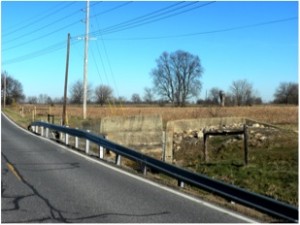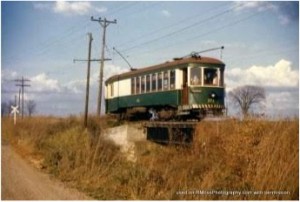by “My Father’s Son”
Keeping Track
When traversing the history of small areas such as Thurmont and its surrounding municipalities, several names begin to be repeated. Dissimilar to culture today, when a family settled in an area, they usually stayed in that area. Our northern Maryland vicinity has collected several names that have a way of emerging from beneath every stone overturned. These surnames provided opportunity for progress and growth within their lineage and society alike. This should be kept in mind for both this series of articles and this attempt to track the Monocacy Valley Railroad (MVRR), and ultimately the Hagerstown and Frederick Railway, from a civic perspective.
Leonard R. Waesche and “Fredericktowne’s” Dr. Steiner Schley built the Monocacy Valley Railroad, a four-mile stretch from the Western Maryland Mainline in Mechanicstown to the Catoctin Furnace. Schley, having followed in his father’s footsteps, was a highly regarded pharmacist, business owner, and advocate for the Maryland School for the Deaf. Schley’s seemingly peculiar association with a railroad venture was extenuated by his résumé, but when explained, the connection between the two was not so odd after all.
The year was 1886; the Catoctin Furnace had been nurtured by John B. Kunkel to the greatest scope of production it would ever experience. During this time, the third stack was built and named for Kunkel’s wife, Deborah. Kunkel passed away in 1885—his wife in 1882—and his estate was left to the control of his children. The heirs placed their father’s trusted bookkeeper, Mr. Waesche, in control of the enterprise, a businessman who knew a railroad would further develop commerce for the furnace. On March 19, 1886, the MVRR received its incorporation certificate, listing Dr. Schley as President, and Mrs. Steiner Schley, born Lillian Kunkel to John Baker and Deborah Bertrand Porter Kunkel, the link to her husband’s investment in the endeavor.
Between 1889 and 1900, the Furnace’s livelihood declined. After the turn of the century, L.R. Waesche moved his family from the Furnace to a Mechanicstown property he had formerly purchased and constructed a section of his railroad through. The Schley’s continued to live on W. Church Street in Frederick with two of their four children, the two others taken by illness during childhood. Their daughter, Lilian Kunkel Schley, would never marry, and their last born, John Reading Schley, would be killed at age twenty-four in a military test flight accident in 1918 in France, concluding this branch of the Schley family. All six are buried at Mt. Olivet Cemetery.
In 1908, the MVRR was sold to the Washington Frederick & Gettysburg Railway Company (WF&G). Monocacy Valley President Schley and L.R. Waesche, and Waesche’s sons, Donald (thirty-six years old) and Russell (twenty-two years old)—all directors—resigned. That same year, bids were submitted to continue WF&G rails from Frederick to meet the Monocacy Valley line near Lewistown. Upon completion, this connection was utilized as a Trolley line under the recognition of the H&F (Hagerstown & Frederick) Railway. The years between 1913 and 1926 marked the Trolley’s heyday. The year 1915 almost saw the extension of the Thurmont line to Emmitsburg by route of Franklinville and St. Anthony’s, but, to the dismay of northern residents, this idea was never realized. In 1920, H&F Trolleys carried a healthy 3.8 million passengers.
The majority of H&F streetcars acquired were used, the last new model purchased in 1921 and manufactured by the J.G. Brill Company of Philadelphia. Brill was the largest manufacturer of “Interurban Coaches” for nearly seventy years, owning plants in six U.S. States, as well as Canada and France. Trolleys were electric, pulling current from power lines, paralleling their tracks through a conducting rod mounted to the car’s roof. The electric lines positioned to power the trolleys also allowed the movement of electricity for commercial use by the railway company. By 1922, sixty-seven percent of the H&F’s revenue came from selling power to farms, homes, and businesses. At this point, the H&F became Potomac Public Service, and in 1923, Potomac Edison, but was seldom referred the rise of personal transportation slowed heavily by 1930, the number of trolley passengers narrowing to 1.5 million that year. Trolley cars were modified to carry more freight than riders, seen as coach windows were covered with the solid paneling used for cargo areas. World War I gas rationing resurrected the trolley, especially the freight division, but this boom was only temporary.
Nevertheless, the Thurmont trolley continued to run until 1954. The Thurmont line was laid from 5th Street in Frederick, through Hood Women’s College, along Rosemont Avenue past Ft. Detrick and on through Yellow Springs, Lewistown, and Catoctin Furnace to Thurmont. Now many households owned two vehicles, replacing people from trolleys to state highways that required increasingly dangerous crossing by the trolley. Occasionally, trolley accidents made headlines, such as one reported by the 1953 Frederick News, regarding a York, PA auto-passenger’s death by broken neck, which on-duty H&F Coach Motorman H.J. Brown described, after a ’47 Chevrolet Coupe struck the trolley as it diagonally crossed Rt. 15 in front of Catoctin Manor one Saturday night. Brown reported both vehicle occupants were thrown through the windshield and the Coupe demolished, none aboard the trolley were hurt.
On the last day of service, seventeen-year-old Carroll James conducted a live radio-broadcast from car 172, the last newly purchased trolley from 1921. James interviewed Potomac Edison President Paul Smith, who even took the car’s controls for a time and conversed how he had ridden the first streetcar to Thurmont, and now the last. In Frederick, the young women of Hood College presented the trolley with songs and flowers as it moved through the campus for the last time. February 20, 1954, marked the final trolley operation in all of Maryland. Scenes from these lost days were recognized by famous Baltimore Sun photojournalist, Aubrey Bodine, in a 1951 photo-story, featuring the H&F. Bodine’s romantic fascination with “old times and old things” included images of the potbelly stove in the Thurmont station and scenery along the route, from in and outside of the trolley car. Bodine’s photograph “Misty Harbor” of a Baltimore tugboat is currently selling for $80,000.
The rails from the top of Carroll Street in Thurmont to Ft. Detrick were removed in 1958; the remaining fragment to the H&F station on East Patrick St. in Frederick has disappeared since, as well. In 1994, fifty-seven-year-old Carroll James would say in his “The H&F: Trolleys Through the Heart of Maryland” documentary that any H&F motorman would agree that each trolley was its own being, a living object with its own personality and temperament and in no way a simple, inanimate object. Today, buildings, bridge abutments, road beds, and grade mounds mark the landscape along the route the trolley once traveled. The path to Frederick is easily followed from Thurmont by tracing these abandoned features, in addition to the pole-lines left along the route like breadcrumbs dropped by No. 172 on that final passage.
Photo taken of the site as it looks today.

Old photo of the trolley crossing one of the old bridges, after crossing Hessong Bridge Road to pass alongside the Firor Farm.


